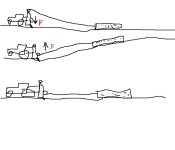plowhog
Elite Member
- Joined
- Dec 8, 2015
- Messages
- 4,048
- Location
- North. NV, North. CA
- Tractor
- Massey 1710 / 1758, Ventrac 4500Y / TD9
Update: I've now winched in about 10 limbs. With and without a snatch block. No problems except when I didn't pull the rope hard enough.
Largest limb is about 22" diameter. I'm cutting limbs into 10-20 foot sections.
No issues with log rolling. The topsoil here is rich. When I drag a limb, it creates a furrow, keeping it stable.
I appreciate all the help and input.
Largest limb is about 22" diameter. I'm cutting limbs into 10-20 foot sections.
No issues with log rolling. The topsoil here is rich. When I drag a limb, it creates a furrow, keeping it stable.
I appreciate all the help and input.


